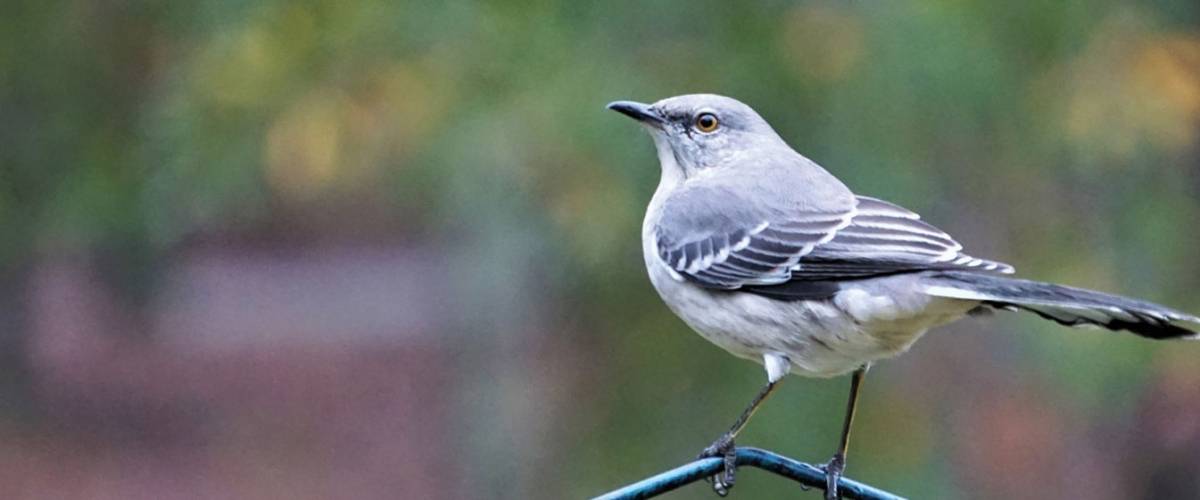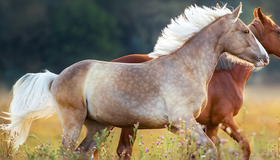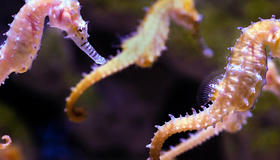
June 17, 2019 – Dr. Kelly Diehl talks with Dr. Jordan Karubian, Associate Professor at Tulane University’s Department of Ecology and Evolutionary Biology, about his latest study, which found that mockingbirds exposed to sub-lethal levels of lead in urban areas display heightened aggression. He says the findings highlight the possibility that sub-lethal lead exposure may be common among other wildlife living in urban areas and more work is needed to better understand its full effects.
00:17 Dr. Kelly Diehl: Welcome to Fresh Scoop Episode 9: What Mockingbirds Can Tell Us About Environmental Lead Contamination. I'm your host, Dr. Kelly Diehl, Morris Animal Foundation's Senior Scientific Programs and Communications Adviser. We hope you're enjoying our podcast series and learning something new with each episode. For those of you who may be new to Fresh Scoop, this is the monthly podcast of Morris Animal Foundation, one of the largest non-profit foundations in the world dedicated to funding studies to find solutions to serious health threats to our animals.
00:50 DD: Founded in 1948 by Dr. Mark Morris Sr., a veterinarian, we've invested more than $126 million in more than 2,600 studies that have improved and protected the health of companion animals, like cats, dogs, and horses as well as wildlife. In each episode, we feature one of the researchers we fund or one of our staff members discussing their work in advancing animal health, whether you're a practicing veterinarian, technician, or student, or just an animal-loving science geek, Fresh Scoop is the podcast for you. You can learn more about us at morrisanimalfoundation.org.
01:29 DD: Okay, on to today's show. Today we're welcoming Dr. Jordan Karubian, an Associate Professor in the Department of Ecology and Evolutionary Biology at Tulane University. Dr. Karubian has recently published a paper titled, "Sub-lethal exposure to lead is associated with heightened aggression in an urban songbird." And he's here with us to discuss his research. Hey, Jordan, thanks for joining us today.
01:54 Dr. Jordan Karubian: My pleasure, Kelly.
01:56 DD: So, before we get into your work, tell me a little bit about how you got interested in ecology in the first place.
02:03 DK: Well, I was always one of those kids, or I was one of those kids who just always loved being outside, and getting my hands dirty digging in the dirt, and going hiking around. So, it really comes from a love of nature and wildlife.
02:18 DD: Thinking of what we're going to talk about today, many of our listeners probably have some awareness of the problem of lead in our environment, but can you give us a sense of the scope of this problem in the United States?
02:32 DK: Yeah, lead is a pervasive problem in the United States and it's a really insidious problem because it's one that affects oftentimes young children who are the innocents among us, which is always tragic and it can cause significant impairments in cognitive development and other sorts of impacts including heightened aggression, which is one of the things that we looked at in, in our study. I guess we'll get to that later.
03:02 DD: Yeah.
03:04 DK: So, lead is common in urban environments around the United States.
03:10 DD: Okay, and you just touched on it, but I think for a lot of us, and I was surprised about this, we think of lead as being banned a long time ago and some items. So why does it continue to be such an issue?
03:25 DK: Yeah, good question. Well, it has a very long half-life which means that it degrades very, very slowly. It basically means that it's not going anywhere. So the two main inputs of lead are, one is from leaded gasoline that cars used prior to being phased out and also leaded paints, which were used to paint houses and other structures for many years, and both of those as you note were phased out several decades ago, and yet the lead persists in our environment because it's from the exhaust of the automobiles, it settles in the soil and then when houses that were painted with lead-based paints get sanded or when the paint chips away, it falls down to the soil and oftentimes it just remains there and it doesn't go anywhere.
04:21 DD: Okay, so even our best attempts it sounds like to rid ourselves of this still causes contamination.
04:31 DK: Yeah, there's remediation steps that have been taken successfully, for example, removing soil that has high concentrations of lead in it or covering that soil up with soil that's not contaminated. But unless those proactive efforts are made, it's something that's really not going anywhere. And I guess another source of input that I should mention, because of the tragedy that's occurred in Flint, Michigan recently, is also lead that's in the pipes of many older cities as well.
05:05 DD: Right, That's a good point. So, let's dive down on your research. And can you tell everyone why lead and why mockingbirds?
05:16 DK: Yeah, well, I moved to New Orleans about a decade ago, and as with many cities in the United States, mockingbirds are common, it's a very common and almost iconic song bird throughout much of the United States. And walking from my house to school and back, I would pay attention to the birds singing and their incredible vocal repertoires that they have. I imagine most of the listeners know, but for those who maybe don't know, mockingbirds gain their name because of their prodigious abilities to mimic sounds in the environment. So, a typical mockingbird learns new songs continuously throughout its life and most efforts to quantify or to measure the full repertoire of an individual mockingbird have been unsuccessful because researchers have found that even after three months or four months of exhaustively recording all the different song types of these birds, they still are introducing new ones into their repertoire. They've got huge repertoires, and it takes a lot of brain space, a lot of brain power to be able to learn those songs and remember them and to sing them with high fidelity.
06:29 DK: So, I started thinking about how lead, which is something that's known to impair cognitive ability might also be impacting their singing ability. And I should just pause for a moment to say that this project is done in collaboration with a number of people, and one of the really early people who was instrumental in coming up with these initial ideas and hypotheses was my colleague and also my wife, Dr. Renata Ribeiro, who's a faculty member here at Tulane as well.
07:03 DD: Cool. And definitely you don't want to forget that collaborator, right?
07:08 DK: Exactly, that's an important one.
[chuckle]
07:11 DD: So, let's start, you've had two projects with the Foundation. Let's start with your pilot project and you alluded a little bit to the complexity of the mockingbird song repertoire. So, give us a quick and dirty overview of your pilot project.
07:28 DK: Great. Well, the pilot project was really just to ask the question, what might be the impacts on the physiology and cognition and behavior of urban wildlife of lead exposure? And I think it's worth saying that there's been a fair amount of work that's been done on wildlife and the effects of lead exposure, but most of that work has been done either on water birds or else carrion eaters, like say the California condor where they come in contact with such high levels of lead like for example, eating a bullet or lead fishing weights for aquatic birds that it basically is lethal for them. And so, there's been work that's shown how a very concentrated, intense intake of lead is enough to kill an animal. But there's been very little work that's been done looking at how levels of lead that are not sufficient to kill the animal, sub-lethal levels of lead might actually be affecting their physiology and behavior.
08:38 DK: So when I started to think about or when we started to think about the fact that there's lead concentrations that are dangerous and potentially impactful in many, most older US cities and then thinking about the number of wildlife individuals and species that are coming into daily contact with that lead, it raises the possibility that there might be currently underappreciated but potentially pretty profound impact affecting potentially millions of animals, both wildlife and also potentially pets.
09:17 DD: Tell us what your results were because I think they're really fascinating.
09:22 DK: Yeah. Well, let me back up for one second if it's okay and talk about the study design a little bit.
09:28 DD: Yeah, go ahead.
09:29 DK: So, what we did, we wanted again to look at potential impacts of lead on the cognition and the physiology and the behavior of mockingbirds, and we're fortunate to have another collaborator, Dr. Howard Mielke who's at the School of Medicine in Tulane, who's done a lot of work looking at the impacts of lead on human development and human cognitive ability and issues like that. And as part of his work, Dr. Mielke made a map of lead concentrations in the soil across the city of New Orleans. And we knew from that, that there were some neighborhoods in New Orleans that had very high levels of lead and that there are other neighborhoods of New Orleans, especially Lakeland, that's been reclaimed within the past few decades and built on after lead paint and leaded gasoline were phased out that have very low levels of lead.
10:31 DK: So, what we did is we chose a number of neighborhoods that varied in lead concentration, we had high-lead neighborhoods and low-lead neighborhoods, and then we also had neighborhoods that varied in the amount of green vegetation that was there. Our goal there was to control for potentially confounding effects of habitat or things other than lead. So what we did is we went out and we caught a bunch of mockingbirds in these different neighborhoods and we found, first of all, sure enough the birds that live in the high-lead neighborhoods also have high concentrations of lead in their systems and their blood and their feathers, so there's this clear linkage that the birds that are in the high-lead neighborhoods have a lot of lead inside of them. So that was an important starting point.
11:20 DK: And then we went on to test potential correlations of impacts on physiology and cognition and behavior. So briefly, our findings in terms of physiological impacts were, we used a pretty blunt instrument, pretty simple tests for that in our pilot work, and we didn't find any strong relationships. And for cognition we used attributes of the birds' singing ability as sort of an index of cognition, so how diverse their song repertoires were and how capable they were of repeating the same songs with a high degree of fidelity, metrics like that. And again, we didn't find any pattern there, but the third aspect that we looked at, our third prediction was that the birds that had higher lead in their systems would also be more aggressive, and we had that prediction because it's a known effect of lead, the heightened aggression, both in terms of animals, laboratory-based studies on lab animals and also on studies on humans.
12:30 DK: So, we had that expectation and to test that, we got a taxidermized mount of a mockingbird, and we put it on a tripod at a standardized distance from free-flying mockingbirds that were all building nests. So, we got them all at the same stage of breeding to control for any differences in aggression that they might have associated with being in different stages of breeding. And we would put the mount to the mockingbird out there. We'd play a song of a mockingbird briefly, and then we would stand back and record the response of these free-flying birds to the taxidermized mount for about 10 minutes. And we knew right away, just anecdotally, and the data certainly supported this, that the birds that are in the high-lead neighborhoods are much more aggressive than are the birds in the low-lead neighborhoods. So, there's this very strong relationship between high lead in the neighborhood, high lead in the birds, more aggressive birds.
13:34 DD: Was that a surprise to you? Did your finding surprise you when you actually looked, went out in the field and did this?
13:43 DK: They did, in part, because just the magnitude of the differences was something that was immediately obvious as an example. After a few trials of this experiment in the high-lead neighborhoods, we had to take our taxidermized mount and we had to put it inside of a cage even though it's a dead stuffed bird, you know?
[laughter]
14:09 DK: And the reason why is because these birds in the high-lead neighborhoods were attacking it with such ferocity that they were ripping the feathers out of it and damaging it to the point where we wouldn't be able to use it anymore for these experiments. I was surprised at the strength of the finding. Yeah.
14:29 DD: You know, at the beginning, of course, I gave the title of this publication and I know that you and I have spoken about how you've been talking about your findings. How's the reaction? What's the reaction you're getting both locally and maybe from other areas of the country about your findings?
14:50 DK: That's a good question. I care a lot about wildlife, and one of the main goals of this research, for me at least, is to explore the degree to which lead exposure is an underappreciated but potentially important risk factor for animals that we share our cities with. But beyond that, as we're all aware, the same risks that are posed to animals are shared by humans. And in the news, there's been a ton of stories in the past few years about whole communities that have just been terribly impacted by lead exposure. So, another goal for me is to use this research as a vehicle to raise public awareness as well about the health risks that are posed particularly to children by lead.
15:52 DK: And it's been really striking for me that how often it is that people are not aware of those risks that exist. Like for example, there'll be times when we're out there with our taxidermized mount in a cage on top of a tripod and someone will walk by and quite reasonably ask what we're doing, and we start to talk to them about the motivations of the study, and these may be people... Sometimes it's people walking with young kids or young kids in strollers and living in very high-lead neighborhoods that pose a real immediate danger to their kids and they're not aware of the risks that exist there.
16:32 DD: That leads me to one question about exactly that, in the communities where you studied this, obviously you've met people when you're out there conducting it, and how have maybe on a smaller level, how they reacted when you told them what you were doing or maybe got publicity for this particular project?
16:56 DK: Yeah, well, you know, I mean there's a range of responses from people that are very interested and want to invite us in to sit down for milk and cookies and talk about it at length. And at the other end of the spectrum, there's people that tell us to get off their lawns, you know?
[chuckle]
17:12 DK: Or move along. I would say most people are interested and not really familiar with and interested with the methods that we're using, and when we start talking about lead and why we're doing this, almost everybody in New Orleans at least has a story where, of the people that we've talked to, that either their own family or the families of friends have been affected by lead where they've gotten a routine test on a kid and it ended up having dangerous... The child has had dangerously high levels and the steps that they've had to take to rectify the situation. So, it's something that really ends up touching a lot of people's lives.
18:01 DD: Have you found that maybe people don't think as much about the potential dangers of lead to what you term urban wildlife and pets?
18:15 DK: Yeah, I think it's been a real blind spot both in the scientific community and the management and policy community as well as the general public. I think it's something that, for whatever reason, people just haven't thought that much about because if you review the literature, our study is one of the first that's really looked at this, and I would say that we're still in the early stages of finding out what the real extent of these impacts are and how broadly they extend. So, with the support of the Morris Animal Foundation, a couple of the things that we're doing right now is I'm working with a new PhD student in my lab named Annelise Blanchette, and she's doing her thesis around how cognition, in particular, of mockingbirds may be affected by lead exposure. So, she's developing more sophisticated tests of cognitive ability that can be administered in the field, as well as in lab-based settings.
19:25 DK: And also collaborating with a new colleague, Dr. Alex Gunderson, who studies anoles lizards, and looking at how lizards may be affected by lead as well. And we have another project that's looking at how lead may be taken up by plants and how that may be transferred to insects, which then are eaten by animals like mockingbirds. So, really trying to understand the breadth and the depth of this situation.
19:54 DD: Alright. So, moving on to just a more general question is, what are some of the challenges, you mentioned it, the kind of get off my grass thing, [chuckle] that you face when you study urban wildlife?
20:09 DK: Well, it's funny, I've done a lot of field-based research on animals, particularly birds, in rainforests, and savannas, and natural areas. This is my first foray into urban ecology because we are working in the city of New Orleans, and there's some real pluses and minuses is what I found. [chuckle] The pluses are that the birds are, you can walk out of your house or out of your office on the campus, and the study system's right there so it's easy to find the birds. But one thing that's been very challenging is that really in a residential neighborhood for example, about 80% of the "habitat" is off-limits to you. So, you can be watching a bird, but then as soon as it flies into someone's backyard, you're done. [chuckle] You're lucky, you have permission to go into that individual backyard. So, it's really constrained the kinds of questions that we can ask and the types of approaches that we can use in this research.
21:15 DD: So, I think a lot of people who are listening, and I think when we think about studying wildlife, just as you mentioned, we think about, "Oh, look, we're going to Africa and we're going out looking at animals," or like you said, rainforests. If you had to make an argument about why it's important to study... Right, the maybe "wildlife" we take for granted, the animals we see around us, or we think they're annoying. Why should we care about studying them, whether it's lead or anything? What's the importance?
21:52 DK: Well, it's a great question. Yeah, I think that my personal take on it is that the human footprint is continuing to grow as our population grows. And internationally, as countries develop and more and more of the population moves into the middle class, we find that the urban areas around the globe are expanding. And in many ways, it's an environment that is increasingly important for diversity and for trajectories of animals, and plants, and the other organisms that we share this planet with. So, I think that it's no longer the case that animals, you only think about real animals, "a real wildlife" as being out in these undisturbed areas. Increasingly, these animals that we share our cities with are important parts of the overall ecological web, I think.
23:02 DK: And I also think that for many people, including myself, seeing these animals in the cities with us, it brightens our day and it raises our spirit in ways that may be difficult to quantify or to put a number on, but that can have a very profound impact on when you're waking up in the morning, if you're lucky enough to hear a bird singing outside your house or outside your apartment, that's an uplifting thing that can really help make it a bright day. [chuckle] So, I think it's important from that sense, as well.
23:37 DD: Yeah, no, I hear what you're saying. So just your take on where do you think we're going to go as far as environmental lead exposure? I think your example, Flint, really brought some issues right to a head, but it's not like there's not been lead around. Where do you see that kind of research, whether it's your research in urban wildlife and human research? Where do you think we're going to go with this?
24:12 DK: I think that's a really good question, and I should preface this response by saying that there's people who have dedicated their entire careers to this particular issue. And I'm something of a new kid on the block in terms of working in lead, in particular. So, I'll give my personal opinion on that with that caveat and it's that I think that lead, like we said at the top of the conversation, it has an extremely long half-life, it's not going anywhere, it's going to be part of the urban environment for a long time to come. But I think what's really critical then is to become aware, is to raise awareness about, first of all, that everybody knows the risks that lead poses. And second of all, that everybody has information about the lead levels in their personal environments, in their backyards, in their water, and on the walk to school that their kids take and the schools of their kids so that people are at least aware of if there's an issue there.
25:25 DK: And then when you have that information, steps can be taken to mediate that issue. That's for humans. And similarly for wildlife, I think that this first study that we've done that we've been talking about in this conversation, it suggests, it doesn't definitively show but there's this very strong suggestion that lead is impacting the behavior of at least this one species of bird and in particular, it's making it more aggressive. And if that's something that is true across the board for a wider range of animals that are living in cities, then it's something that could really be impacting the way that... Why it is that some species are more successful than other species in cities for example, and why is it that some species disappear while other ones like house sparrows or mockingbirds persist and do well, this may be part of the puzzle.
26:26 DD: And just to finish up in it, and you just alluded to it again in your answers, what do you think is the most important take home message for people from the past study, the pilot study that we funded and of course your ongoing research? If you could tell people one thing, what would it be?
26:47 DK: Well, I'm going to say two things, if that's okay with you?
[laughter]
26:49 DD: Yeah.
26:49 DK: Because there's the public health aspect of this and then there's the wildlife and well-being of animals aspect of it, which in many ways are one in the same. I guess, in some ways it's just being aware of the health risks that are posed, whether it's to humans or to animals. And once you have that information, then it's much easier to come up with a rational and effective strategy of how to proceed whether it's in terms of your daily habits and taking care of your kids or whether it's taking care of the animals that we share our cities with.
27:30 DD: That's awesome. Well, thanks Jordan for joining us today and telling us about this issue and describing your research, and I'm really excited to see what your next project with us and your other projects are going to tell us about this in the future and I wish you ongoing good luck. It's just a really, really cool study.
27:52 DK: Well, thank you so much for those kind words and thank you also for the support. We couldn't have done it without the Morris Animal Foundation, and we're also very excited to see what we find out next so stay tuned.
28:05 DD: Yeah, it sounds great. Well, you have a great day. And again, thanks a bunch Jordan for popping on the phone with us.
28:12 DK: Okay, thanks Kelly.
28:13 DD: Alright, take care.
28:13 DK: Bye.
28:14 DD: Bye.
28:15 DD: That does it for this episode of Fresh Scoop. Once again, thanks to Dr. Jordan Karubian for joining us. We'll be back with another episode next month that we hope you'll find just as informative. The science of animal health is ever changing and veterinarians need cutting edge research information to give their patients the best possible care, and that's why we're here. You can find us on iTunes, Spotify, Google Podcasts, and Stitcher. To learn more about Morris Animal Foundation's work, again, go to morrisanimalfoundation.org. There you'll see just how we bridge science and resources to advance the health of animals. You can also follow us on Facebook, Twitter, and Instagram. I'm Dr. Kelly Diehl and we'll talk soon.




